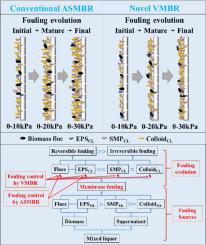Water Research ( IF 11.4 ) Pub Date : 2022-01-18 , DOI: 10.1016/j.watres.2022.118098 Chuansheng Wang 1 , Tze Chiang Albert Ng 2 , Meiyue Ding 2 , How Yong Ng 2

|
Membrane fouling remains a major hindrance to a prevalent application of membrane bioreactor (MBR) for wastewater treatment. Vibrating membrane technology has recently attracted increasing attention in energy-efficient fouling control in MBR compared to air sparging. However, little is known about its fundamental fouling control mechanism and whether the vibrating MBR (VMBR) is a highly effective strategy to control fouling constitutions and fouling sources compared to the conventional air-sparging MBR (ASMBR). This study operated two parallel MBRs with vibrating or air-sparging membrane modules for long-term (215 d) real domestic wastewater treatment. Effects of air sparging and vibration rates on fouling control, fouling development and fouling sources across three fouling stages were comprehensively evaluated. Results showed that the VMBR achieved 70% lower fouling rates compared to the ASMBR due to a remarkable retardation in each fouling stage by membrane vibration. The VMBR significantly reduced over 62.7% of colloidCL and SMPCL within the cake layer (CL) to simultaneously alleviate the reversible and irreversible fouling compared to the ASMBR. The comparatively lower dissolved organic matter (DOM) and biopolymer contents in the cake layer of the VMBR resulted in a slower TMP rise. The main DOMs in the foulants of both MBRs were found in the following order: aromatic protein > soluble microbial by-products > other organics. EPSML from mixed liquor (ML) contributed more DOMs to form membrane foulant than the SMPML in both MBRs. Aromatic proteins and soluble microbial products in the EPSML were markedly reduced in the VMBR but increased in the ASMBR in high-shear phase, demonstrating higher effectiveness in fouling control by membrane vibration. This study provided insights into understanding fouling control, fouling development characteristics and fouling mechanisms between the VMBR and ASMBR, which might guide the researchers and engineers to apply novel vibrating MBRs to better control membrane fouling for holistic wastewater treatment in full scale.
中文翻译:

新型振动式 MBR 和空气喷射式 MBR 在不同污染阶段的污染发展和特征在生活废水处理中的见解
膜污染仍然是膜生物反应器 (MBR) 在废水处理中普遍应用的主要障碍。与空气喷射相比,振动膜技术最近在 MBR 中的节能结垢控制方面引起了越来越多的关注。然而,对于其基本的污垢控制机制以及与传统的空气喷射 MBR (ASMBR) 相比,振动 MBR (VMBR) 是否是控制污垢构成和污垢来源的高效策略知之甚少。本研究运行了两个平行的 MBR,带有振动或空气喷射膜组件,用于长期(215 天)的实际生活废水处理。综合评价了空气喷射和振动速率对三个污垢阶段的污垢控制、污垢发展和污垢来源的影响。结果表明,由于膜振动在每个结垢阶段的显着延迟,与 ASMBR 相比,VMBR 的结垢率降低了 70%。VMBR 显着减少超过 62.7% 的胶体与 ASMBR 相比,饼层 (CL) 内的CL和 SMP CL可同时减轻可逆和不可逆的结垢。VMBR 滤饼层中相对较低的溶解有机物 (DOM) 和生物聚合物含量导致 TMP 上升较慢。两种 MBR 污垢中的主要 DOM 依次为:芳香蛋白 > 可溶性微生物副产物 > 其他有机物。来自混合液 (ML) 的EPS ML比两种 MBR 中的 SMP ML贡献了更多的 DOM 以形成膜污染。EPS ML中的芳香蛋白和可溶性微生物产品在 VMBR 中显着减少,但在 ASMBR 中在高剪切阶段增加,表明通过膜振动控制污垢的有效性更高。本研究为了解 VMBR 和 ASMBR 之间的污染控制、污染发展特征和污染机制提供了见解,这可能会指导研究人员和工程师应用新型振动 MBR 来更好地控制膜污染,以实现全面的废水处理。











































 京公网安备 11010802027423号
京公网安备 11010802027423号